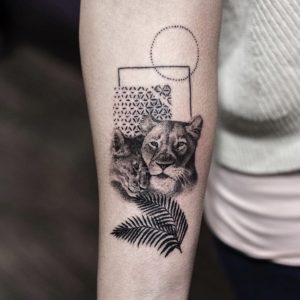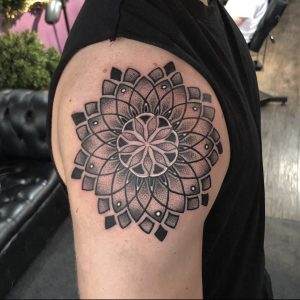Dotwork Tattooing
Recent years have seen a revival in the tattoo style known as dotwork, particularly as it has begun to become blended with other styles, complimenting each other. It is a tattooing technique where the artist creates a design with a multitude of dots, rather than full lines or fill. It can be incredibly intricate, and It shows off one form of artistry from afar, and another level entirely when you come up close to it.
The magic dot
The dot is a foundation for an array of possibilities. They can become a line, function as shading, or create a beautiful gradient from darker to lighter blacks and greys.

Dotwork can be applied to construct intricate patterns, shading, or entire motives. Often it is used to make ornate mandalas or repetitive symbols known as sacred geometry. The latter is usually made up by the ‘flower of life’ symbol, chambered nautilus cells or mathematical patterns, and it lends itself very well to the meditative repetition of dotworking.
Other recurring themes and motives are symbols like ‘the eye of God’, the Hamsa hand, lacework, animal portraits or animal and human skulls.
Shading and negative space
Dotwork can also be used on other tattooing techniques to create shading, in this case it is known as ‘stippling’, and can as such conjure incredibly realistic depths. It is usually done with black or grey ink, but at times a few red dots will be added for visual effect of the motive.
One of the features on the rise that becomes particularly stunning with this technique is the ‘negative space’ tattoo, where the dots make up the borders, and the design itself is made up of the ‘empty’ surface of the naked skin.
If dots are nailed so closely to each other that the overall visual effect is mainly that of a black surface, it is known as ‘blackwork’. Today dotwork tattoos are often used to cover large surfaces on the body, such as patterned full sleeves, pieces that cover the entire torso, or even full body suits.

Handpoking
Dotwork has its origin in handpoked tattoos, and the shamanic tattoo healers in Asian, Maori and ancient Egyptian communities, with religious or spiritual inspirations. Many modern day dotwork artists and have gone back to handpoking. This is where the artist pushes the ink into the skin without the use of an electric tattoo machine, resembling ancient tattooing techniques. Tattooing by hand takes a great deal longer than using a machine, but a lot of artists find that in return it gives them greater control and precision with detail.
Dotwork mandalas
One of the most common motives for a dotwork tattoo is the mandala. ‘Mandala’ is the Sanskrit word for circle. It is made up of shapes and symbols that radiate out from the centre, built on symmetry, and becomes a symbolism for balance of body and mind. It has therefore been used in meditative techniques for Bushhist monks for centuries, and has a special role in Hinduist traditions, and even Christian artwork, specifically found in rose designs in stained glass windows in churches.
